|
|
|
|
|
Indian River Lagoon 101
|
|
|
|
Overview and Habitats
|
|
|
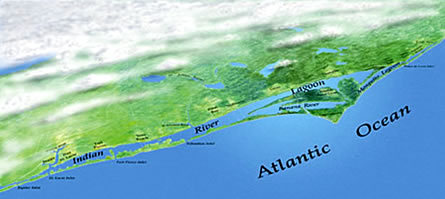 The
Indian River Lagoon was originally
named the Rio De Ais by early Spanish
Explorers due to the large numbers of
Ais Indians living along its shores.
While often referred to as the "Indian
River", in reality it is not a river at
all. Instead it is an estuarine lagoon
formed by the formation of the barrier
island complex to the east about 7,000
years ago. The entire system actually
encompasses three major water bodies,
the Indian River Lagoon, the Banana
River (again not actually a river). and
the Mosquito Lagoon, and stretches 156
miles along Florida's east coast from
Ponce De Leon inlet in Volusia County to
the north to Jupiter Inlet in Palm Beach
County to the south. In between there
are three additional inlets, Sebastain
Inlet at the border of Brevard and
Indian River Counties, Fort Pierce Inlet
in St. Lucie County, and St. Lucie Inlet
in Martin County. There are also many
freshwater tributaries to the lagoon and
due to the variances in salinity as well
as the fact the the northern portion of
the lagoon is located in a temperate
climatic zone while the southern portion
is subtropical, the lagoon has the
highest biodiversity of any estuarine
ecosystem in North America, including
over 700 fish species. For this reason
the Indian River Lagoon system is one of
the top fisheries in the country. Below
we will discuss the primary habitats of
the lagoon and their importance to
fishing success. The
Indian River Lagoon was originally
named the Rio De Ais by early Spanish
Explorers due to the large numbers of
Ais Indians living along its shores.
While often referred to as the "Indian
River", in reality it is not a river at
all. Instead it is an estuarine lagoon
formed by the formation of the barrier
island complex to the east about 7,000
years ago. The entire system actually
encompasses three major water bodies,
the Indian River Lagoon, the Banana
River (again not actually a river). and
the Mosquito Lagoon, and stretches 156
miles along Florida's east coast from
Ponce De Leon inlet in Volusia County to
the north to Jupiter Inlet in Palm Beach
County to the south. In between there
are three additional inlets, Sebastain
Inlet at the border of Brevard and
Indian River Counties, Fort Pierce Inlet
in St. Lucie County, and St. Lucie Inlet
in Martin County. There are also many
freshwater tributaries to the lagoon and
due to the variances in salinity as well
as the fact the the northern portion of
the lagoon is located in a temperate
climatic zone while the southern portion
is subtropical, the lagoon has the
highest biodiversity of any estuarine
ecosystem in North America, including
over 700 fish species. For this reason
the Indian River Lagoon system is one of
the top fisheries in the country. Below
we will discuss the primary habitats of
the lagoon and their importance to
fishing success. |
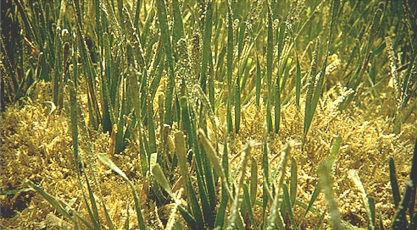 Seagrass
Flats; The average depth of the
Indian River Lagoon is about four feet
and historically, seagrass flats covered
almost the entire bottom. While
stormwater pollutants from development
have significantly reduced the abundance
of seagrasses they still remain one the
most important vegetation communities in
the lagoon. Seagrasses, unlike algae,
are vascular plants related to
terrestrial grasses that evolved into
their present state as water levels rose
after the last ice age and today form
the basis of the food chain of the
lagoon. Shrimp, crabs and many other
invertebrates use the seagrass beds as a
nursery area as well as cover from
predators as do juvenile fishes of many
species. In addition, mullet, a primary
food source for many gamefish species,
feed on the algae that form on the
blades of the seagrasses and in turn
help to fuel the entire ecosystem. As
such the seagrass beds offer some of the
most productive and exciting fishing
opportunities in the lagoon system,
particularly during the summer baitfish
season when reds, seatrout, snook,
tarpon, and other species are chasing
the schools of juvenile finger mullet
that crowd the flats each summer through
fall. Seagrass
Flats; The average depth of the
Indian River Lagoon is about four feet
and historically, seagrass flats covered
almost the entire bottom. While
stormwater pollutants from development
have significantly reduced the abundance
of seagrasses they still remain one the
most important vegetation communities in
the lagoon. Seagrasses, unlike algae,
are vascular plants related to
terrestrial grasses that evolved into
their present state as water levels rose
after the last ice age and today form
the basis of the food chain of the
lagoon. Shrimp, crabs and many other
invertebrates use the seagrass beds as a
nursery area as well as cover from
predators as do juvenile fishes of many
species. In addition, mullet, a primary
food source for many gamefish species,
feed on the algae that form on the
blades of the seagrasses and in turn
help to fuel the entire ecosystem. As
such the seagrass beds offer some of the
most productive and exciting fishing
opportunities in the lagoon system,
particularly during the summer baitfish
season when reds, seatrout, snook,
tarpon, and other species are chasing
the schools of juvenile finger mullet
that crowd the flats each summer through
fall. |
|
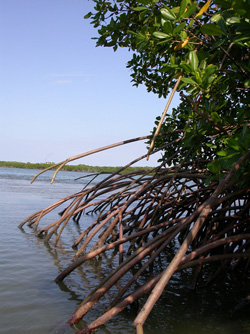 Mangrove
Forests line many of the undeveloped
shorelines of the lagoon and provide a
vital food source and cover for many
prey species. In fact studies by the
Smithsonian Marine Station at Fort
Pierce have shown that the density of
small fish within the mangrove forests
can be as much as 35 times the density
of small fishes on adjacent grass flats.
Mangrove leaves contribute to the food
chain by decomposing rapidly after
falling into the water. As they
decompose into small particles they
become a primary food source for small
fish and invertebrates. This in turn
causes the mangrove shorelines to become
magnets for larger gamefish species Mangrove
Forests line many of the undeveloped
shorelines of the lagoon and provide a
vital food source and cover for many
prey species. In fact studies by the
Smithsonian Marine Station at Fort
Pierce have shown that the density of
small fish within the mangrove forests
can be as much as 35 times the density
of small fishes on adjacent grass flats.
Mangrove leaves contribute to the food
chain by decomposing rapidly after
falling into the water. As they
decompose into small particles they
become a primary food source for small
fish and invertebrates. This in turn
causes the mangrove shorelines to become
magnets for larger gamefish species
|
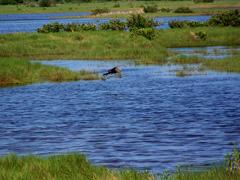 Salt
Marshes are an extremely important
component of the lagoon habitat, serving
as both a nursery for juvenile gamefish
and a major producer of forage for
larger gamefish. While the extreme
shallow depths of the water typically
excludes larger fish from hunting
directly among the salt marsh grasses
they will prowl the shallow flats along
the outer edges. Also in areas near
inlets where there is a greater tidal
influence high tides can be a good time
to explore these areas as well as
adjacent grass flats when the tides are
going out, washing baitfish and shrimps
into waters deep enough for gamefish to
hunt. Salt
Marshes are an extremely important
component of the lagoon habitat, serving
as both a nursery for juvenile gamefish
and a major producer of forage for
larger gamefish. While the extreme
shallow depths of the water typically
excludes larger fish from hunting
directly among the salt marsh grasses
they will prowl the shallow flats along
the outer edges. Also in areas near
inlets where there is a greater tidal
influence high tides can be a good time
to explore these areas as well as
adjacent grass flats when the tides are
going out, washing baitfish and shrimps
into waters deep enough for gamefish to
hunt. |
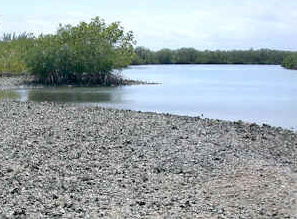 Oyster
Flats can be found in some parts of the
lagoon system, particularly in the
Northern Reaches of Mosquito Lagoon
around Oak Hill and can be great fishing
habitats. While Black Drum may feed on
the oysters themselves, many other
species of gamefish such as redfish
seatrout snook tarpon and sheepshead
seek out the many species of crabs,
shrimp, barnacles, flatworms on other
small creatures that make their homes
within the crevasses of an oyster reef. Oyster
Flats can be found in some parts of the
lagoon system, particularly in the
Northern Reaches of Mosquito Lagoon
around Oak Hill and can be great fishing
habitats. While Black Drum may feed on
the oysters themselves, many other
species of gamefish such as redfish
seatrout snook tarpon and sheepshead
seek out the many species of crabs,
shrimp, barnacles, flatworms on other
small creatures that make their homes
within the crevasses of an oyster reef. |
Gamefish Species
The Indian River Lagoon within the
Space Coast area offers a diverse
selection of gamefish to try for
with a variety of baits and lures
being effective. Different species
will require different techniques
and baits. The list below is divided
into two groups, Pelagic Feeders and
Bottom Feeders.
|
|
|
|
Pelagic Feeders
feed throughout the water column but
place a greater emphasis on the
middle and upper levels and will
take both live shrimp and baitfish
such as finger mullet, glass minnows
and other schooling species. They
can be caught on a variety of lures
including topwater and subsurface
plugs, spoons, jighead lures, both
feather or bucktail and soft plastic
types.
|
 Seatrout
are one of the four most popular
gamefish along the Space Coast, reaching
a maximum size of about 20 pounds
although the average will be much
smaller, about 2 lbs. They will hit live
shrimp, finger mullet, pigfish, and many
other baitfish species. Early morning
topwater plugs cast over shallow
grassflats can bring explosive strikes
from larger trout. On deeper flats of
about 2-4 feet in depth, other lures
such as spoons, plastic and bucktail
jigs, and subsurface plugs like the
suspending mirrolure series can also
produce. During the summer, school size
trout from 10 to about 15 inches can be
caught near schools of glass minnows and
found congregating on 2-4- foot flats
and often around docks and other
structures. Trout can also be caught
around mangrove lined shorelines in
canals and other deeper areas. During
the coldest months of the year large
groups will tend to congregate in deeper
holes and canals connected to the lagoon
when baits must be worked deep and slow
in order to entice a hit. Good eating
though catch and released is encouraged.
Closed seasons and slot limits apply,
click here for current fishing
regulations. Florida is
divided into three management zones for
seatrout. For reference, the Space Coast
is in the Southern Region. Seatrout
are one of the four most popular
gamefish along the Space Coast, reaching
a maximum size of about 20 pounds
although the average will be much
smaller, about 2 lbs. They will hit live
shrimp, finger mullet, pigfish, and many
other baitfish species. Early morning
topwater plugs cast over shallow
grassflats can bring explosive strikes
from larger trout. On deeper flats of
about 2-4 feet in depth, other lures
such as spoons, plastic and bucktail
jigs, and subsurface plugs like the
suspending mirrolure series can also
produce. During the summer, school size
trout from 10 to about 15 inches can be
caught near schools of glass minnows and
found congregating on 2-4- foot flats
and often around docks and other
structures. Trout can also be caught
around mangrove lined shorelines in
canals and other deeper areas. During
the coldest months of the year large
groups will tend to congregate in deeper
holes and canals connected to the lagoon
when baits must be worked deep and slow
in order to entice a hit. Good eating
though catch and released is encouraged.
Closed seasons and slot limits apply,
click here for current fishing
regulations. Florida is
divided into three management zones for
seatrout. For reference, the Space Coast
is in the Southern Region. |
 Redfish
are also one of the four most popular
gamefish species along the Space Coast,
in fact the Redfish of the north Indian
River lagoon and particularly the
Mosquito lagoon are rapidly gaining
world wide acclaim. Redfish like to
school over shallow grass flats feeding
on shrimp crabs and mullet as well as
other bait species that they can catch,
particularly in the summer months. They
can have caught on these same bits as
well as topwater plugs, spoons, soft
plastic baits and jigs. They can also be
readily caught on cut mullet or a blue
crab cut in half and fished along the
bottom as they are more opportunistic
feeders than seatrout. They can reach
about 50 lbs, however the average is
about 6 pounds. Good eating though catch
and released is encouraged. No closed
season but slot limits apply.
Click here for current fishing
regulations Redfish
are also one of the four most popular
gamefish species along the Space Coast,
in fact the Redfish of the north Indian
River lagoon and particularly the
Mosquito lagoon are rapidly gaining
world wide acclaim. Redfish like to
school over shallow grass flats feeding
on shrimp crabs and mullet as well as
other bait species that they can catch,
particularly in the summer months. They
can have caught on these same bits as
well as topwater plugs, spoons, soft
plastic baits and jigs. They can also be
readily caught on cut mullet or a blue
crab cut in half and fished along the
bottom as they are more opportunistic
feeders than seatrout. They can reach
about 50 lbs, however the average is
about 6 pounds. Good eating though catch
and released is encouraged. No closed
season but slot limits apply.
Click here for current fishing
regulations |
 Snook
are another member of the 'Big Four"
along the Space Coast. Primarily ambush
predators they will hug mangrove
shorelines along the lagoons, in canals,
at the mouth of creeks, under docks and
along rocks and oyster bars. For live
bait use jumbo live shrimp, finger
mullet, or pigfish. They can be very
finicky, especially under heavy fishing
pressure. Best times are at dawn or dusk
and can be caught readily at night
around lit docks. I have personally been
fishing at Sebastian Inlet during the
day when no one was getting a hit, put
on snorkeling gear and found large
schools of snook along the bottom of the
inlet just ignoring every offering. Then
after dark with an outgoing tide they
are attacking everything. Always use a
fluorocarbon leader when targeting snook
as they have an abrasive mouth as well
as razor sharp gill plates that can also
cut your hand if improperly handled
(been there, done that). Strong fighters
when hooked and will often jump. They
can reach about 50 pounds with the
average being 5 or 6 pounds. Snook are a
subtropical to tropical species and
cannot tolerate cold water so the best
fishing will be summer and fall. Great
on the table! Closed seasons (Catch and
Release) and slot limits apply. A "Snook
Tag" must be purchased to keep one.
Click here for current fishing
regulations. Snook
are another member of the 'Big Four"
along the Space Coast. Primarily ambush
predators they will hug mangrove
shorelines along the lagoons, in canals,
at the mouth of creeks, under docks and
along rocks and oyster bars. For live
bait use jumbo live shrimp, finger
mullet, or pigfish. They can be very
finicky, especially under heavy fishing
pressure. Best times are at dawn or dusk
and can be caught readily at night
around lit docks. I have personally been
fishing at Sebastian Inlet during the
day when no one was getting a hit, put
on snorkeling gear and found large
schools of snook along the bottom of the
inlet just ignoring every offering. Then
after dark with an outgoing tide they
are attacking everything. Always use a
fluorocarbon leader when targeting snook
as they have an abrasive mouth as well
as razor sharp gill plates that can also
cut your hand if improperly handled
(been there, done that). Strong fighters
when hooked and will often jump. They
can reach about 50 pounds with the
average being 5 or 6 pounds. Snook are a
subtropical to tropical species and
cannot tolerate cold water so the best
fishing will be summer and fall. Great
on the table! Closed seasons (Catch and
Release) and slot limits apply. A "Snook
Tag" must be purchased to keep one.
Click here for current fishing
regulations. |
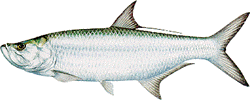 Tarpon
are the largest of the big four as
well as the largest species of Herring
in the world, able to grow over 200
pounds. Along the Space Coast they seem
to get up to about 75 to 100 pounds with
the average being anywhere from 5 to 20.
In some side creeks if you pay attention
you can occasionally find 8 to 12 inch
juveniles which can be great fun on
ultralight tackle. When hooked they will
put on an aerial display you will never
forget. They will attack topwater and
subsurface plugs, spoons, jigs, and soft
baits. Shrimp, mullet, and other live
baits also work. They will take dead
fish off of the bottom. These fish have
very tough mouths to set a hook in and
do require the use of a fluorocarbon
leader. Not much food value but a
"Tarpon Tag" is required if you want to
keep one for mounting.
Click here for current fishing
regulations. Tarpon
are the largest of the big four as
well as the largest species of Herring
in the world, able to grow over 200
pounds. Along the Space Coast they seem
to get up to about 75 to 100 pounds with
the average being anywhere from 5 to 20.
In some side creeks if you pay attention
you can occasionally find 8 to 12 inch
juveniles which can be great fun on
ultralight tackle. When hooked they will
put on an aerial display you will never
forget. They will attack topwater and
subsurface plugs, spoons, jigs, and soft
baits. Shrimp, mullet, and other live
baits also work. They will take dead
fish off of the bottom. These fish have
very tough mouths to set a hook in and
do require the use of a fluorocarbon
leader. Not much food value but a
"Tarpon Tag" is required if you want to
keep one for mounting.
Click here for current fishing
regulations. |
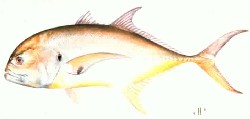 Jack
Crevalle are powerful, fast, and
voracious feeders when found around
schools of glass minnows during the
summer months. Hook one of any size to
it on light tackle and you are in for a
fight. The average size in the lagoon is
about 2 lbs but can get up to about 50
pounds as adults offshore. Use a shock
leader to protect against cutoffs. Not
much food value and the catch is not
regulated. Jack
Crevalle are powerful, fast, and
voracious feeders when found around
schools of glass minnows during the
summer months. Hook one of any size to
it on light tackle and you are in for a
fight. The average size in the lagoon is
about 2 lbs but can get up to about 50
pounds as adults offshore. Use a shock
leader to protect against cutoffs. Not
much food value and the catch is not
regulated. |
 Ladyfish
are like a poor man's tarpon as
immediately upon being hooked will take
to the air. In fact, both fish are in
the same family of Elipodae. They feed
primarily on small fish but will take a
live shrimp Largely nocturnal, can be
found attacking glass minnows and other
tiny schooling fish in large numbers at
which time they will hit almost any lure
thrown their way. Ladyfish can reach 15
pounds but most will be under 3 pounds.
In the lagoon the average size is about
1 pounds and fish caught there will be
juveniles who will move to the ocean to
live before reaching sexual maturity.
Not much food value and the catch is not
regulated. Ladyfish
are like a poor man's tarpon as
immediately upon being hooked will take
to the air. In fact, both fish are in
the same family of Elipodae. They feed
primarily on small fish but will take a
live shrimp Largely nocturnal, can be
found attacking glass minnows and other
tiny schooling fish in large numbers at
which time they will hit almost any lure
thrown their way. Ladyfish can reach 15
pounds but most will be under 3 pounds.
In the lagoon the average size is about
1 pounds and fish caught there will be
juveniles who will move to the ocean to
live before reaching sexual maturity.
Not much food value and the catch is not
regulated. |
 Bluefish
are primarily associated with surf
fishing along the space coast but will
come into the lagoon especially in the
vicinity of inlets. Traveling in schools
they can be voracious feeders, gorging
themselves on baitfish and striking
nearly anything cast to them. Size and
bag limits apply.
Click here for current fishing
regulations Bluefish
are primarily associated with surf
fishing along the space coast but will
come into the lagoon especially in the
vicinity of inlets. Traveling in schools
they can be voracious feeders, gorging
themselves on baitfish and striking
nearly anything cast to them. Size and
bag limits apply.
Click here for current fishing
regulations |
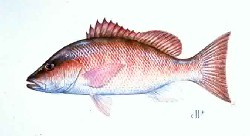 Mangrove
Snapper are also known as Gray
Snapper and can be found in the lagoon
around rocky shorelines, under docks, in
mangrove creeks and also out over the
grass flats. Inshore they are usually
much less than 10 lbs as the adults tend
to congregate on offshore reefs. They
can be caught on jigs, spoons and
smaller rapala type plugs as well as
live shrimp. Good eating and limits do
apply.
Click here for current fishing
regulations. Mangrove
Snapper are also known as Gray
Snapper and can be found in the lagoon
around rocky shorelines, under docks, in
mangrove creeks and also out over the
grass flats. Inshore they are usually
much less than 10 lbs as the adults tend
to congregate on offshore reefs. They
can be caught on jigs, spoons and
smaller rapala type plugs as well as
live shrimp. Good eating and limits do
apply.
Click here for current fishing
regulations. |
|
Bottom Feeders
typically specialize on feeding on
shrimps, crabs and other
invertebrate life forms along the
bottom of the lagoon and will not
normally feed on baitfish such as
mullet
|
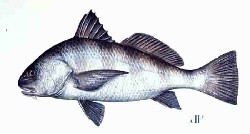 Black
Drum can grow to a maximum size of
110 lbs but the average in the lagoon is
about 10 lbs. They normally feed on
shrimp, crabs, clams and oysters,
crunching the later two with rows of
rounded teeth and powerful jaws. Those
targeting larger drum should fish with
fairly stout tackle in the 20 to 50 lb.
test range and use an adult blue crab
with the top shell removed and then cut
in half or a quarter to fit a 4/0 to 9/0
size hook on or near the bottom in a
channel, and wait. They can also be
caught aground bridge pilings, oyster
bars and both submerged structure. Then
again they can sometimes be seen
"tailing" over shallow sand or mud flats
as they dig in the substrate for clams
and other foods. Drum can be good eating
but the quality drops off once the fish
grows beyond about 5 pounds. Size and
bag limits apply.
Click here for current fishing
regulations. Black
Drum can grow to a maximum size of
110 lbs but the average in the lagoon is
about 10 lbs. They normally feed on
shrimp, crabs, clams and oysters,
crunching the later two with rows of
rounded teeth and powerful jaws. Those
targeting larger drum should fish with
fairly stout tackle in the 20 to 50 lb.
test range and use an adult blue crab
with the top shell removed and then cut
in half or a quarter to fit a 4/0 to 9/0
size hook on or near the bottom in a
channel, and wait. They can also be
caught aground bridge pilings, oyster
bars and both submerged structure. Then
again they can sometimes be seen
"tailing" over shallow sand or mud flats
as they dig in the substrate for clams
and other foods. Drum can be good eating
but the quality drops off once the fish
grows beyond about 5 pounds. Size and
bag limits apply.
Click here for current fishing
regulations. |
|
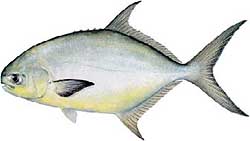 Pompano
are another fish normally targeted in
the surf but can be caught in the lagoon
on sandy flats on pompano jigs and other
types of jigs and grubs. Later in the
summer they will congregate near bridges
and piers as they gather for the exodus
offshore for spawning. Maximum size is
about 8 lbs with their average being
about 1 1/2 to 2 lbs. Great eating and
size and bag limits apply.Click
here for current fishing regulations. Pompano
are another fish normally targeted in
the surf but can be caught in the lagoon
on sandy flats on pompano jigs and other
types of jigs and grubs. Later in the
summer they will congregate near bridges
and piers as they gather for the exodus
offshore for spawning. Maximum size is
about 8 lbs with their average being
about 1 1/2 to 2 lbs. Great eating and
size and bag limits apply.Click
here for current fishing regulations.
|
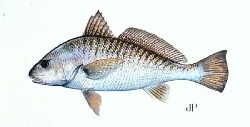 Atlantic
Croaker are a small relative to the
Black Drum and can be caught on the
bottom using cut shrimp, clams, and sand
fleas on a size 2 hook. Jigs tipped with
cut shrimp will also work. The average
size is under a pound with the maximum
being about 3-4 pounds. They are good
eating and are not regulated. Atlantic
Croaker are a small relative to the
Black Drum and can be caught on the
bottom using cut shrimp, clams, and sand
fleas on a size 2 hook. Jigs tipped with
cut shrimp will also work. The average
size is under a pound with the maximum
being about 3-4 pounds. They are good
eating and are not regulated. |
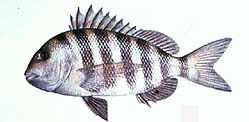 Sheepshead
can be seen cruising the flats but are
really more suited for life among rocks,
pilings, oyster reefs and other hard
surface structures. They have small
mouths with teeth that look almost human
and small hooks are best when targeting
them. They commonly eat small crabs,
barnacles, small bivalves and other
creatures found attached to structure.
Fishing with live fiddler crabs as bait
next to bridge pilings is a very
effective way of landing them. Mole
crabs (sand fleas) and shrimp, (either
live or fresh cut) however, are other
effective baits. If targeting them off
of a bridge or pier it is best to use
tackle of at least 12 to 20 lb. test,
stand to one side of the piling, not
directly over and drop a line next to
the piling with enough weight to get the
bait to the bottom and be ready to pull
them away from the piling after hookup
as they can quickly wrap the line around
the piling. The bite will be fairly soft
and they are experts at stealing bait
off of a hook. Good eating and size and
bag limits apply.
Click here for current fishing
regulations.. Sheepshead
can be seen cruising the flats but are
really more suited for life among rocks,
pilings, oyster reefs and other hard
surface structures. They have small
mouths with teeth that look almost human
and small hooks are best when targeting
them. They commonly eat small crabs,
barnacles, small bivalves and other
creatures found attached to structure.
Fishing with live fiddler crabs as bait
next to bridge pilings is a very
effective way of landing them. Mole
crabs (sand fleas) and shrimp, (either
live or fresh cut) however, are other
effective baits. If targeting them off
of a bridge or pier it is best to use
tackle of at least 12 to 20 lb. test,
stand to one side of the piling, not
directly over and drop a line next to
the piling with enough weight to get the
bait to the bottom and be ready to pull
them away from the piling after hookup
as they can quickly wrap the line around
the piling. The bite will be fairly soft
and they are experts at stealing bait
off of a hook. Good eating and size and
bag limits apply.
Click here for current fishing
regulations.. |
 Whiting
are yet another fish normally associated
with surf fishing but also can be caught
in the lagoon. They feed on a variety of
small invertebrates and can be caught on
cut shrimp, clams, mole crabs (sand
fleas) and jigs tipped with shrimp. They
are good eating and are non-regulated. Whiting
are yet another fish normally associated
with surf fishing but also can be caught
in the lagoon. They feed on a variety of
small invertebrates and can be caught on
cut shrimp, clams, mole crabs (sand
fleas) and jigs tipped with shrimp. They
are good eating and are non-regulated.
|
|
|
|
|
|
Flats Fishing
is by far the most popular style of
fishing along the Space Coast with
seatrout and redfish being the two most
popular species sought, and for good
reason, it is a combination of fishing
and hunting and when a gator seatrout or
big redfish strikes a topwater "walk the
dog" type lure like a Mirrolure Top Pup
or a Mirromullet, it is the most
exciting fishing there is. Especially
when you see the fish before you cast or
you see a hump of water approaching the
lure during the retrieve. the main thing
to remember when fishing the flats is
QUIET! Be very quiet. Fish in shallow
water are skittish because they do feel
exposed and will leave an area or quit
feeding if it becomes obvious to them
that they are being targeted. Flats
fishing can be done from a shallow draft
boat, a canoe or kayak, from the
shoreline but your coverage are will be
limited, or by wading. If wading be sure
to shuffle your feet along the bottom to
avoid accidently stepping on a stingray.
The best flats to fish are those where
the seagrasses have been able to thrive
over the years. In many areas near major
towns and cities the grass coverage on
the flats has been greatly reduced by
stormwater runoff and been replaced
brown algaes. There are usually some
fish in the area and they can be caught
off of city docks and seawalls but areas
where the shoreline development has been
minimal, non existant or done so with
proper stormwater facilities and
shoreline vegetation preservation
requirements present will usually have
more intact seagrass beds nearby and
provide better fishing opportunties.
Examples of these areas would be the
waters surrounding the Merritt Island
National Wildlife Refuge, the Thousand
Islands area of Cocoa Beach in the
Banana River and the south area of the
Space Coast near Sebastain Inlet. Most
of the grasses seem to be concentrated
along the eastern shorlines in all three
major bodies of water within the lagoon
system. Flats that are adjacient to
deeper channels seem to provide the best
fishing. |
 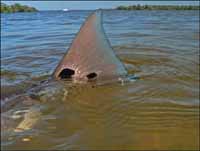 Sight
Fishing; When sight fishing the
flats a good pair of polarizing
sunglasses is highly recommended as it
will greatly reduce glare from the
surface of the water allowing better
vision of the bottom. Redfish spotted on
the flats will most likely be moving as
they tend to browse the grasses looking
for prey. They can also frequently be
seen "tailing" due to the fact that they
spend a large amount of time grubbing
the bottom for crabs, marine worms,
shrimp, and other invertebrates.Big
trout and snook on the other hand will
often be waiting motionless among the
seagrasses waiting to ambush prey that
swims by, and will be much harder to
see. Either way, when you have spotted
your target the last thing you will want
to do is cast directly on top of the
fish as this will spook them into
fleeing, ending any chance of catching
them. Cast about six to eight in front
of the direction the fish is facing and
about the same distance or more beyond Sight
Fishing; When sight fishing the
flats a good pair of polarizing
sunglasses is highly recommended as it
will greatly reduce glare from the
surface of the water allowing better
vision of the bottom. Redfish spotted on
the flats will most likely be moving as
they tend to browse the grasses looking
for prey. They can also frequently be
seen "tailing" due to the fact that they
spend a large amount of time grubbing
the bottom for crabs, marine worms,
shrimp, and other invertebrates.Big
trout and snook on the other hand will
often be waiting motionless among the
seagrasses waiting to ambush prey that
swims by, and will be much harder to
see. Either way, when you have spotted
your target the last thing you will want
to do is cast directly on top of the
fish as this will spook them into
fleeing, ending any chance of catching
them. Cast about six to eight in front
of the direction the fish is facing and
about the same distance or more beyond
|
 Potholes;
On healthy grass flats in the lagoon you
will find open sandy areas locally
called "potholes". In warmer weather,
seatrout will often take up ambush sites
along the edge of these potholes waiting
for any small baitfish that venture over
the open water above the potholes. By
artificial lures or natural baits
through these areas you can often score
some great action. The diagram at left
shows a good way of working a larger
pothole by strategically placing your
casts so that you do not spook other
trout that may be working the edges of
the area. After a siginificant cold
spell in winter, the potholes serve a
different function for the fish. On a
sunny day after a cold night the sandy
bottom will serve as a solar collecter,
warming the water over the pothole as
the sun rises in the sky. The trout and
other species will be directly over the
pothole soaking up the extra warmth. So
while searching the grass flats for
trout and other fish during any time of
the year, don't ignore the potholes. Potholes;
On healthy grass flats in the lagoon you
will find open sandy areas locally
called "potholes". In warmer weather,
seatrout will often take up ambush sites
along the edge of these potholes waiting
for any small baitfish that venture over
the open water above the potholes. By
artificial lures or natural baits
through these areas you can often score
some great action. The diagram at left
shows a good way of working a larger
pothole by strategically placing your
casts so that you do not spook other
trout that may be working the edges of
the area. After a siginificant cold
spell in winter, the potholes serve a
different function for the fish. On a
sunny day after a cold night the sandy
bottom will serve as a solar collecter,
warming the water over the pothole as
the sun rises in the sky. The trout and
other species will be directly over the
pothole soaking up the extra warmth. So
while searching the grass flats for
trout and other fish during any time of
the year, don't ignore the potholes. |
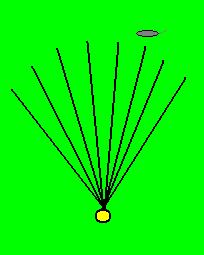 While
site fishing the flats is certainly the
most exciting way to fish the flats it
is not the only way and can be very
difficult under poor lighting conditions
or of there is a light chop to the
water, especially if gator seatrout are
on the agenda. A gator seatrout is any
trout over 7 lbs. and is most likely
female. They don't school like younger
trout or redfish and unlike redfish
which will tend to move around browsing
the bottom for food or chasing mullet,
gator trout are ambush predators, taking
up station, remaining motionless and
waiting for a small fish to swim into
ambush range. They are not going to be
chasing fish or lures all over the
flats. Another reason is that these
trout are most active at dawn or dusk,
meaning much less light to work with.
They are also very very wary, having
survived a minimum of six years living
in a marine environment with dolphins,
larger fish, birds, sharks, and other
predators wishing to make a meal of
them. To blind cast for possibly the
largest trout of the day, cast as far
from your position as possible with
topwater plugs like the Mirromullet and
work the area in a fanning pattern. It
is slow and tedious but it does work.
Random casting is basically a crapshoot
for every cast you make as you may cast
just outside of a trout's ambush range
on one cast and cast completely away
from it the next, never realizing how
close you were. While
site fishing the flats is certainly the
most exciting way to fish the flats it
is not the only way and can be very
difficult under poor lighting conditions
or of there is a light chop to the
water, especially if gator seatrout are
on the agenda. A gator seatrout is any
trout over 7 lbs. and is most likely
female. They don't school like younger
trout or redfish and unlike redfish
which will tend to move around browsing
the bottom for food or chasing mullet,
gator trout are ambush predators, taking
up station, remaining motionless and
waiting for a small fish to swim into
ambush range. They are not going to be
chasing fish or lures all over the
flats. Another reason is that these
trout are most active at dawn or dusk,
meaning much less light to work with.
They are also very very wary, having
survived a minimum of six years living
in a marine environment with dolphins,
larger fish, birds, sharks, and other
predators wishing to make a meal of
them. To blind cast for possibly the
largest trout of the day, cast as far
from your position as possible with
topwater plugs like the Mirromullet and
work the area in a fanning pattern. It
is slow and tedious but it does work.
Random casting is basically a crapshoot
for every cast you make as you may cast
just outside of a trout's ambush range
on one cast and cast completely away
from it the next, never realizing how
close you were. |
 Canals
can be great places to fish, especially
if they are deeper than the adjacient
lagoon waters and lined by mangrove
trees. Trout, snapper, snook and many of
the other species either set up ambush
points or prowl along the mangrove roots
looking for prey among the many species
of small fish and invertibrates that
take up refuge among the prop roots.
After a series of cold spells in the
winter, trout especially can will
congregate in the deeper waters of the
canal. You must remember that the fish
will be more sluggish during the colder
times and very slow to bite. Use you
soft jigs and other deep water baits and
work them very slowly along the bottom. Canals
can be great places to fish, especially
if they are deeper than the adjacient
lagoon waters and lined by mangrove
trees. Trout, snapper, snook and many of
the other species either set up ambush
points or prowl along the mangrove roots
looking for prey among the many species
of small fish and invertibrates that
take up refuge among the prop roots.
After a series of cold spells in the
winter, trout especially can will
congregate in the deeper waters of the
canal. You must remember that the fish
will be more sluggish during the colder
times and very slow to bite. Use you
soft jigs and other deep water baits and
work them very slowly along the bottom. |
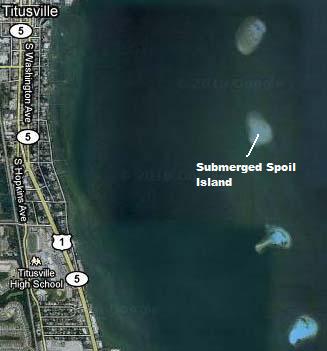 Spoil
Islands; Years ago, the Army Corp of
Engineers dredged a channel the length
of the Indian River lagoon to create the
Intracoastal Waterway, an inland
shipping channel extending from Texas
around Florida and northward to New
Jersey. A by-product of this dredging
can be seen today along the lagoon in
the form of "spoil islands" where the
sand dredged to deepen the channel was
dumped alongside the channel. Today many
of them still exist and have become
ecosystems supporting numerous bird,
animal, and plant species. And they can
be a great place to fish for a variety
of species. Some of them are no longer
visible above the waterline except that
dead trees can be seen above the
surface. Great fishing can be found
around many of them as they are usually
close to deep water, yet over the years
they have formed sandbars, flats, coves,
and other structure that can attract a
great variety of fish. Obviously islands
that have eroded below the water surface
may be hard to see while in a boat, so a
little homework on Google Maps (www.google.com/maps)
can be an invaluable tool. Open the
website, use your mouse to zoom in on
the lagoon area you will be fishing,
click on the "satellite view" and you
can plainly see most of the submerged
islands in the lagoon to pinpoint their
position while in most cases be able to
see sandbars, cuts, etc. Above left is a
view of submerged spoil islands along
the Intracoastal Waterway off of
Titusville. Spoil
Islands; Years ago, the Army Corp of
Engineers dredged a channel the length
of the Indian River lagoon to create the
Intracoastal Waterway, an inland
shipping channel extending from Texas
around Florida and northward to New
Jersey. A by-product of this dredging
can be seen today along the lagoon in
the form of "spoil islands" where the
sand dredged to deepen the channel was
dumped alongside the channel. Today many
of them still exist and have become
ecosystems supporting numerous bird,
animal, and plant species. And they can
be a great place to fish for a variety
of species. Some of them are no longer
visible above the waterline except that
dead trees can be seen above the
surface. Great fishing can be found
around many of them as they are usually
close to deep water, yet over the years
they have formed sandbars, flats, coves,
and other structure that can attract a
great variety of fish. Obviously islands
that have eroded below the water surface
may be hard to see while in a boat, so a
little homework on Google Maps (www.google.com/maps)
can be an invaluable tool. Open the
website, use your mouse to zoom in on
the lagoon area you will be fishing,
click on the "satellite view" and you
can plainly see most of the submerged
islands in the lagoon to pinpoint their
position while in most cases be able to
see sandbars, cuts, etc. Above left is a
view of submerged spoil islands along
the Intracoastal Waterway off of
Titusville. |
|
Abandoned or neglected docks; Along
the shores of the lagoon you will find
many docks that have fallen into various
stages of neglect. Those that are no
longer useable or are just not used
often can be great fishing hotspots by
offerring great hiding places for wary
gamefish to hide as well as cover for
bait species. Seatrout and snook
especially will take up residence under
these structures. When approching these
docks do not just motor within casting
range and start firing away. You will
put the fish out of feeding mode in a
heartbeat. If possible, pole or drift
within casting distance and try to put
your lures and baits as close to the
dock as possible. The best is actually
landing your bait slightly underneath
the dock. This can be done slightly
later in the day after an early morning
of fishing the flats. These docks are
also great places to try for sheepshead,
snapper, drum and other species. |
|
Use the Internet! The photo just
below I retrieved by opening (www.google.com/maps)
as mentioned above and typing in Long
Point Park, Melbourne Beach Fl.
(Continued below picture)

After hitting the search button you will
come to a map showing the location of
the park. If not already set, click on
"Satellite" view and it changes from map
mode to Landsat satellite imagery. then
you can zoom in on a particular area by
double clicking on the spot you want to
zoom in on. You can back out using the
slidebar at the left.
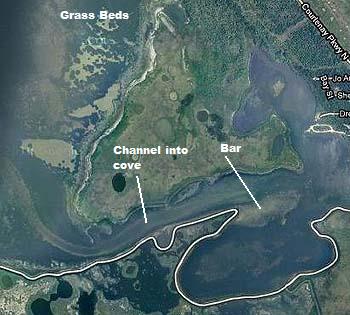 Depending
on the water clarity at the time the
image was made you will be able to see
bottom structure and areas covered by
aquatic vegetation, as well as deeper
holes sandbars, cuts and channels, etc,
as demonstrated by this image of Dummits
Cove on Merritt Island National Wildlife
Refuge. You can also get there by just
opening the website and double clicking
on the part of the country you want to
see, then using the mouse to drag the
image around to explore the area. In
this way you can actually explore an
area you have never fished before and
have a little more knowlege about the
area when you do go. Depending
on the water clarity at the time the
image was made you will be able to see
bottom structure and areas covered by
aquatic vegetation, as well as deeper
holes sandbars, cuts and channels, etc,
as demonstrated by this image of Dummits
Cove on Merritt Island National Wildlife
Refuge. You can also get there by just
opening the website and double clicking
on the part of the country you want to
see, then using the mouse to drag the
image around to explore the area. In
this way you can actually explore an
area you have never fished before and
have a little more knowlege about the
area when you do go.
|
|
|
|
|